|
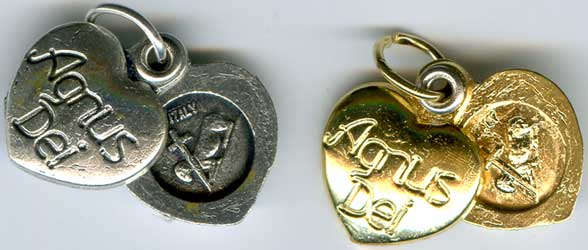
Here are the two Agnus Dei that I have. The silver one
is attached to my Holy Rosary and I wear the gold one. These two were consecrated in the traditional manner during Easter
season of 1964 by Pope Paul VI. Inexplicably, he did not ever consecrate the Agnus Dei again. Nor has any Supreme Pontiff
since. No offiical reason has ever been given by Rome as to why the ancient and revered practice was abandoned.
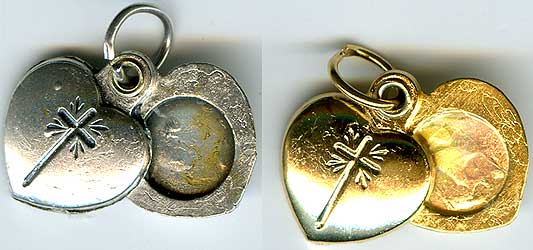
Although its origin is shrouded
in the mist of antiquity, the sacramental Agnus Dei is first mentioned in historical Church accounts as early as the sixth
century, and referred to frequently by the early to middle ninth century. Thus, for over ten centuries the Agnus Dei has been
a popular and treasured sacramental to Catholics.
The name "Agnus Dei" was given to special discs of wax impressed
with the figure of a lamb, the "Lamb of God" which were blessed by the reigning Pope in a ceremony so solemn that the Pope
was said to consecrate the sacramentals. Popes traditionally consecrated Agnus Deis only during the first year of their pontificate
and again every seven years.
In earlier times, on Holy Saturday, the Pope, with the assistance of the Archdeacon of
Rome, prepared the wax from the previous year's paschal candles, adding both chrism and balsam to the wax. The Agnus Deis
were subsequently consecrated on the Wednesday of Easter week and distributed on Saturday of the same week. In more recent
times, the wax was prepared by monks, dipped in water mixed with chrism after being formed and then consecrated by the Pope
and distributed. When visiting Cardinals would visit the Holy Father, an Agnus Dei wax disc, or multiple disc, would
be placed into his miter. The Cardinals then distributed the Agnus Deis as they saw fit, and also sewn into small pouches
of various shapes by nuns to keep them clean and safe or pressed into heart-shaped lockets.
As in the paschal candle,
the wax typifies the virgin flesh of Christ, the cross associated with the lamb suggests the idea of a victim offered in sacrifice,
and as the blood of the paschal lamb of old protected each household from the destroying angel, so the purpose of these consecrated
medallions is to protect those who wear or possess them from all malign influences. In the Pope’s prayers of blessing,
special mention is made specifically for protection in combat, protection against tempests, of the perils of storm and pestilence,
lightning, from fire and flood; malice of demons and of every adversity; sickness, and a sudden and unprovided death, and
also of the dangers to which women are exposed in childbirth. Miraculous effects have been believed to follow the use of these
objects of piety. Fires are said to have been extinguished, and floods stayed. (Vol. 1, p. 220 - Catholic Encyclopedia 1913
Edition).
In a wonderful article by Charles Hugo Doyle, entitled "The Forgotten Sacramental," the author provides a
summary of the special virtues of the Agnus Dei, as cited by Popes Urban V, Paul II, Julius III, Sixtus V and Benedict XIV,
which include the following benefits:
They foster piety, banish tepidity, preserve from vice and dispose
to virtue.
They cancel venial sins and purify from the stain left by grievous sin after it has been remitted in the Sacrament
of Penance,
They banish evil spirits, deliver from temptation and preserve from eternal ruin.
They are a protection
from a sudden and unprovided death.
They dispel fears occasioned by evil spirits.
They are a protection in combat,
and have power to ensure victory.
They deliver from poison and from the snares of the wicked.
They are excellent preventatives
against sickness and are also an efficacious remedy -- especially in cases of epilepsy.
They hinder the ravages of pestilence,
of epidemics and infectious diseases.
They quiet the winds, dissipate hurricanes, calm whirlwinds, and keep away tempests.
They save from shipwreck and the danger of lightning and floods. An anecdote is recalled here of Pope St. Pius V, who
had recourse to this expedient when the Tiber was in flood and seemed likely to submerge the city. We are told that when an
Agnus Dei had been thrown into the river, the angry waters at once subsided.
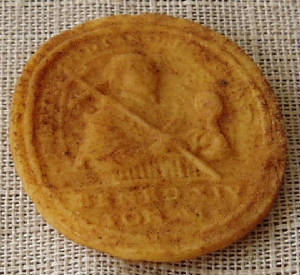
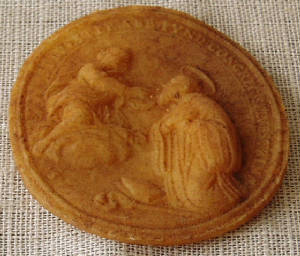
ANGUS DEI
ANGUS DEI
Dated 1741
Dated 1832
from
from
Pope
Benedict XIV
Pope Gregory XVI
(1740-1758)
(1831-1846)
Figure of: Figure of:
Saint
Norbert
Saint Sylvester
(c1080-1134) (1177-1267)
size: 50mm size: 80mm
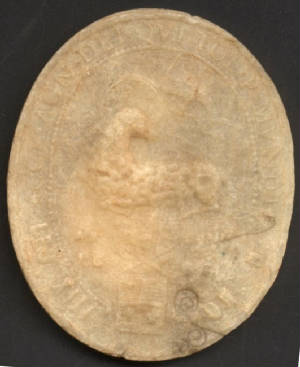
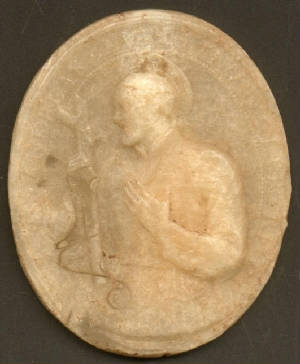
ANGUS DEI
Dated 1880
from
Pope Leo XIII
(1878-1903)
Figure of:
Saint Andreas
(c3-60)
size:
80mm
Return to Holy Relic Page
Return to Devotion Page
Return to Home Page
|
